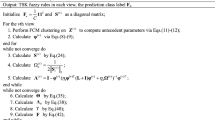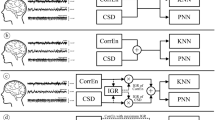Abstract
Most intelligent algorithms used for recognizing epilepsy electroencephalogram (EEG) have two major deficiencies. The one is the lack of interpretability and the other is unsatisfactory recognition results. In response to these challenges, we propose a dedicated model called multi-view Takagi–Sugeno–Kang (TSK) fuzzy system (MV-TSK-FS) for the epilepsy EEG detection. Our contributions lie in three aspects. First, TSK-FS is selected as the basic model. As one of the most famous fuzzy systems, TSK-FS has the advantage of nice interpretability and thus meets the requirement of clinic trials and applications. Second, MV-TSK-FS uses a multi-view framework to collaboratively handle the collective feature data extracted from diverse extraction perspectives, which strives to avoid the potential performance degradation commonly incurred with single feature extraction. Third, we propose a view-weighted mechanism based on the quadratic regularization to distinguish the importance of each view. The more important the view, the larger the corresponding weight is. The final decision is consequently figured out with the weighted outputs of all views. Experimental results demonstrate that, compared with other epilepsy EEG detection ones, our proposed method has better classification performance as well as more satisfied interpretability on results.




















Similar content being viewed by others
References
Acharya UR, Sree SV, Swapna G et al (2013) Automated EEG analysis of epilepsy: a review. Knowl-Based Syst 45(3):147–165
Andrzejak RG, Lehnertz K, Mormann F et al (2001) Indications of nonlinear deterministic and finite-dimensional structures in time series of brain electrical activity: dependence on recording region and brain state. Phys Rev E 64(6):061907
Chao G, Sun S (2016) Alternative multi-view maximum entropy discrimination. IEEE Trans Neural Netw Learn Syst 27(7):1445–1456
Chen Z, Xie K (2019) A review of EEG-based analysis and classification methods. China Med Equip 16:151–158
Cui S, Duan L, Qiao Y et al (2018) Learning EEG synchronization patterns for epileptic seizure prediction using bag-of-wave features. J Ambient Intell Human Comput. https://doi.org/10.1007/s12652-018-1000-3
Deivasigamani S, Senthilpari C, Yong WH (2020) Machine learning method based detection and diagnosis for epilepsy in EEG signal. J Ambient Intell Human Comput. https://doi.org/10.1007/s12652-019-01495-9
Delsy TTM, Nandhitha NM, Rani BS (2020) Feasibility of spectral domain techniques for the classification of non-stationary signals. J Ambient Intell Human Comput. https://doi.org/10.1007/s12652-020-02220-7
Deng ZH, Choi KS, Chung FL, Wang ST (2011) Scalable TSK fuzzy modeling for very large datasets using minimal-enclosing-ball approximation. IEEE Trans Fuzzy Syst 19(2):210–226
Deng Z, Jiang Y, Chung F-L, Ishibuchi H, Wang S (2013) Knowledge-leverage-based fuzzy system and its modeling. IEEE Trans Fuzzy Syst 21(4):597–609
Deng Z, Choi K-S, Jiang Y, Wang S (2014) Generalized hidden-mapping ridge regression knowledge-leveraged inductive transfer learning for neural networks fuzzy systems and kernel methods. IEEE Trans Cybern 44(2):2585–2599
Dhanalakshmi R, Anitha K, Rukmani Devi D et al (2020) Association rule generation and classification with fuzzy influence rule based on information mass value. J Ambient Intell Human Comput. https://doi.org/10.1007/s12652-020-02280-9
Dian JA, Colic S, Chinvarun Y, Carlen PL, Bardakjian BL (2015) Identification of brain regions of interest for epilepsy surgery planning using support vector machines. In: 2015 37th annual international conference of the IEEE engineering in medicine and biology society (EMBC), pp 6590–6593
Eroğlu K, Kurt P, Kayıkçıoğlu T, Osman O (2015) Determining the effect of luminance on the EEG measurement with STFT method. In: 2015 medical technologies national conference (TIPTEKNO), pp 1–4
Hu D, Ma X et al (2020) A new method of voltage flicker detection based on short time Fourier transform. Power Syst Clean Energy 36(3):27–33
Huang C, Chung F-L, Wang S (2016) Multi-view L2-SVM and its multi-view core vector machine. Neural Netw 75:110–125
Iscan Z, Dokur Z, Demiralp T (2011) Classification of electroencephalogram signals with combined time and frequency features. Expert Syst Appl 38(8):10499–10505
Jiang Y, Chung FL, Ishibuchi H et al (2015b) Multitask TSK fuzzy system modeling by mining intertask common hidden structure. IEEE Trans Cybern 45(3):548–561
Jiang Y, Deng Z, Chung F-L, Wang S (2015a) Multi-task TSK fuzzy system modeling using inter-task correlation information. Inf Sci 298:512–533
Jiang S, Min W, Lyu Y, Liu L (2020) Few-shot food recognition via multi-view representation learning. ACM Trans Multimed Comput Commun Appl 16(3):1–20
Kilinc O, Uysal I (2015) Source-aware partitioning for robust cross-validation. In: 2015 IEEE 14th international conference on machine learning and applications (ICMLA), pp 1083–1088
Koçak O, Beytar F, Fırat H, Telatar Z, Eroğul O (2016) Comparison of non-parametric PSD detection methods in the anaylsis of EEG signals in sleep apnea. In: 2016 medical technologies national congress (TIPTEKNO), pp 1–4
Lai D et al (2019) Automated detection of high frequency oscillations in intracranial EEG using the combination of short-time energy and convolutional neural networks. IEEE Access 7:82501–82511
Lasefr Z, Ayyalasomayajula SSVNR, Elleithy K (2017) Epilepsy seizure detection using EEG signals. In: 2017 IEEE 8th annual ubiquitous computing, electronics and mobile communication conference (UEMCON), pp 162–167
Liu J, Ren Z (2010) The research and application of the multi-view registration. In: 2010 3rd international congress on image and signal processing, pp 1258–1262
Lu R-K, Liu J-W, Lian S-M, Zuo X (2019) Multi-view representation learning in multi-task scene. Neural Comput Appl 32:10403–10422
Memar P, Faradji F (2018) A novel multi-class EEG-based sleep stage classification system. IEEE Trans Neural Syst Rehabil Eng 26(1):84–95
Mirowski P et al (2009) Classification of patterns of EEG synchronization for seizure prediction. Clin Neurophysiol 120(11):1927–1940
Miyamoto S, Umayahara K (1998) Fuzzy clustering by quadratic regularization. In: Proceedings of the 1998 IEEE international conference on fuzzy systems and IEEE world congress on computational intelligence, pp 1394–1399
Morshed BI, Khan A (2014) A brief review of brain signal monitoring technologies for BCI applications: challenges and prospects. J Bioeng Biomed Sci 4(1):1–10
Mu Z, Hu J (2009) Research of EEG identification computing based on AR model. In: 2009 international conference on future biomedical information engineering (FBIE), pp 366–368
Nishad A, Pachori RB (2020) Classification of epileptic electroencephalogram signals using tunable-Q wavelet transform based filter-bank. J Ambient Intell Human Comput. https://doi.org/10.1007/s12652-020-01722-8
Parvinnia E, Sabeti M, Jahromi MZ, Boostani R (2014) Classification of EEG signals using adaptive weighted distance nearest neighbour algorithm. J King Saud Univ Comput Inf Sci 26(1):1–6
Rajya Lakshmi M, Prasad TV, Chandra Prakash V (2014) Survey of EEG signals processing methods. Int J Adv Res Comput Sci Softw Eng 4(1):84–91
Samiee K, Kovacs P, Gabbouj M (2015) Epileptic seizure classification of EEG time-series using rational discrete short-time fourier transform. IEEE Trans Biomed Eng 62(2):541–552
Shah SA, Fan D, Ren A et al (2018) Seizure episodes detection via smart medical sensing system. J Ambient Intell Human Comput 11:4363–4375
Sharma R, Pachori RB (2015) Classification of epileptic seizures in EEG signals based on phase space representation of intrinsic mode functions. Expert Syst Appl 42:1106–1117
Sonbol AH, Fadali MS, Jafarzadeh S (2012) TSK fuzzy function approximators: design and accuracy analysis. IEEE Trans Syst Man Cybern B Cybern 42(3):702–712
Takagi T, Sugeno M (1985) Fuzzy identification of systems and its application to modeling and control. IEEE Trans Syst Man Cybern SMC 15(1):116–132
Tang Y, Durand DM (2012) A tunable support vector machine assembly classifier for epileptic seizure detection. Expert Syst Appl 39:3925–3938
Tayeb S, Mahmoudi A, Regragui F, Himmi MM (2014) Efficient detection of P300 using Kernel PCA and support vector machine. In: 2014 second world conference on complex systems (WCCS), pp 17–22
Tzallas AT, Tsipouras MG, Fotiadis DI (2009) Epileptic seizure detection in eegs using time-frequency analysis. IEEE Trans Inf Technol Biomed 13(5):703–710
Umale C, Vaidya A, Shirude S, Raut A (2016) Feature extraction techniques and classification algorithms for EEG signals to detect human stress—a review. Int J Comput Appl Technol Res 5(1):8–13
Vlcek Z (2014) Analysis of autoregressive fuzzy systems. In: 2004 IEEE international conference on fuzzy systems (IEEE Cat. No.04CH37542) vol 3, pp 1233–1238
Wang G, Deng Z, Choi K-S (2015) Detection of epileptic seizures in EEG signals with rule-based interpretation by random forest approach. In: Proceedings of 11th international conference (ICIC), pp 738–744
Yang M, Deng C, Nie F (2019) Adaptive-weighting discriminative regression for multi-view classification. Pattern Recogn 88(4):236–245
Zhang Y, Dong J, Zhu J, Wu C (2019a) Common and special knowledge-driven TSK fuzzy system and its modeling and application for epileptic EEG signals recognition. IEEE Access 7:127600–127614
Zhang Y, Li J, Zhou X et al (2019b) A view-reduction based multi-view TSK fuzzy system and its application for textile color classification. J Ambient Intell Human Comput. https://doi.org/10.1007/s12652-019-01495-9
Zhang C, Cui Y, Han Z, Zhou JT, Fu H, Hu Q (2020) Deep partial multi-view learning. IEEE Trans Pattern Anal Mach Intell 1–1
Zhu C, Miao D, Wang Z, Zhou R, Wei L, Zhang X (2020) Global and local multi-view multi-label learning. Neurocomputing 371:67–77
Acknowledgements
This work was supported in part by the National Natural Science Foundation of China under Grants 61702225, 61772241, and U20A20228, by the 2018 Six Talent Peaks Project of Jiangsu Province under Grant XYDXX-127, by a Science and Technology Demonstration Project for the Social Development of Wuxi under Grant WX18IVJN002, and by the Jiangsu Committee of Health under Grant H2018071.
Author information
Authors and Affiliations
Corresponding author
Additional information
Publisher's Note
Springer Nature remains neutral with regard to jurisdictional claims in published maps and institutional affiliations.
Rights and permissions
About this article
Cite this article
Li, Y., Qian, P., Wang, S. et al. Novel multi-view Takagi–Sugeno–Kang fuzzy system for epilepsy EEG detection. J Ambient Intell Human Comput 14, 5625–5645 (2023). https://doi.org/10.1007/s12652-021-03189-7
Received:
Accepted:
Published:
Issue Date:
DOI: https://doi.org/10.1007/s12652-021-03189-7




